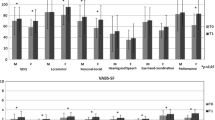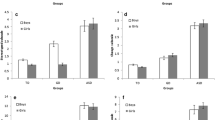Abstract
Gender dysphoria (GD) and autism spectrum disorder (ASD) are associated. In 49 GD children (40 natal males), we examined ASD risk factors (i.e., birth weight, parental age, sibling sex ratio) in relation to autistic traits. Data were gathered on autistic traits, birth weight, parents’ ages at birth, sibling sex ratio, gender nonconformity, age, maternal depression, general behavioral and emotional problems, and IQ. High birth weight was associated with both high gender nonconformity and autistic traits among GD children. Developmental processes associated with high birth weight are, therefore, likely to underlie the GD–ASD link either directly or indirectly. The present study is the first to provide quantitative data bearing on possible mechanisms that lead GD and ASD to co-occur.
Similar content being viewed by others
References
Abel, K. M., Dalman, C., Svensson, A. C., Susser, E., Dal, H., Idring, S., et al. (2013). Deviance in fetal growth and risk of autism spectrum disorder. American Journal of Psychiatry, 170, 391–398. doi:10.1176/appi.ajp.2012.12040543.
Achenbach, T. M. (1991). Manual for the child behavior checklist/4-18 and 1991 profile. Burlington, VT: University of Vermont Department of Psychiatry.
Alanko, K., Santtila, P., Harlaar, N., Witting, K., Varjoen, M., Jern, P., et al. (2010). Common genetic effects of gender atypical behavior in childhood and sexual orientation in adulthood: A study of Finnish twins. Archives of Sexual Behavior, 39, 81–92. doi:10.1007/s10508-008-9457-3.
Alley, C. S., Gillberg, C., & Wilson, P. (2014). Neurobiological abnormalities in the first few years of life in individuals later diagnosed with autism spectrum disorder: A review of recent data. Behavioural Neurology. doi:10.1155/2014/210780.
American Psychiatric Association. (2013). Diagnostic and statistical manual of mental disorders (5th ed.). Arlington, VA: Author.
Avidime, O. M., Avidime, S., Olorunshola, K. V., & Dikko, A. A. U. (2011). Anogenital distance and umbilical cord testosterone level in newborns in Zaria, Northern Nigeria. Nigerian Journal of Physiological Sciences, 26, 23–28.
Bennett, T., Boyle, M., Georgiades, K., Georgiades, S., Thompson, A., Duku, E., et al. (2012). Influence of reporting effects on the association between maternal depression and child autism spectrum disorder behaviors. Journal of Child Psychology and Psychiatry, 53, 89–96. doi:10.1111/j.1469-7610.2011.02451.x.
Blanchard, R., Zucker, K. J., Bradley, S. J., & Hume, C. S. (1995). Birth order and sibling sex ratio in homosexual male adolescents and probably prehomosexual feminine boys. Developmental Psychology, 31, 22–30. doi:10.1037/0012-1649.31.1.22.
Blanchard, R., Zucker, K. J., Cavacas, A., Allin, S., Bradley, S. J., & Schachter, D. C. (2002). Fraternal birth order and birth weight in probably prehomosexual feminine boys. Hormones and Behavior, 41, 321–327. doi:10.1006/hbeh.2002.1765.
Blumberg, S. J., Bramlet, M. D., Kogan, M. D., Schieve, L. A., Jones, J. R., & Lu, M. C. (2013). Changes in prevalence of parent-reported autism spectrum disorder in school-aged U.S. children: 2007–2012. National Health Statistics Reports, 65, 1–11.
Carlsen, S. M., Jacobsen, G., & Romundstad, P. (2006). Maternal testosterone levels during pregnancy are associated with offspring size at birth. European Journal of Endocrinology, 155, 365–370. doi:10.1530/eje.1.02200.
Chasson, G. S., Timpano, K. R., Greenberg, J. L., Shaw, A., Singer, T., & Wilhelm, S. (2011). Shared social competence impairment: Another link between the obsessive-compulsive and autism spectrums? Clinical Psychology Review, 31, 653–662. doi:10.1016/j.cpr.2011.02.006.
Constantino, J. N., & Gruber, C. P. (2005). Social responsiveness scale. Los Angeles: Western Psychological Services.
Côté, K., Blanchard, R., & Lalumière, M. L. (2003). The influence of birth order on birth weight: Does the sex of preceding siblings matter? Journal of Biosocial Science, 35, 455–462. doi:10.1017/S0021932003004553.
de Vries, A. L. C., Noens, I. L., Cohen-Kettenis, P. T., van Berckelaer-Onnes, I. A., & Doreleifers, T. A. (2010). Autism spectrum disorders in gender dysphoric children and adolescents. Journal of Autism and Developmental Disorders, 40, 930–936. doi:10.1007/s10803-010-0935-9.
Derogatis, L. R. (1994). Symptom checklist-90-R. Minneapolis: National Computer Systems Inc.
Dodds, L., Fell, D. B., Shea, S., Armson, B. A., Allen, A. C., & Bryson, S. (2011). The role of prenatal, obstetric and neonatal factors in the development of autism. Journal of Autism and Developmental Disorders, 41, 891–902. doi:10.1007/s10803-010-1114-8.
Fombonne, E. (2005). Epidemiology of autistic disorder and other pervasive developmental disorders. Journal of Clinical Psychiatry, 66(Supplement 10), 3–8.
Fukumoto, A., Hashimoto, T., Mori, K., Tsuda, Y., Arisawa, K., & Kagami, S. (2011). Head circumference and body growth in autism spectrum disorders. Brain and Development, 33, 569–575. doi:10.1016/j.braindev.2010.09.004.
Gayle, H. D., Yip, R., Frank, M. J., Nieburg, P., & Binkin, N. J. (1988). Validation of maternally reported birth weights among 46,637 Tennessee WIC program participants. Public Health Reports, 103, 143–147.
Gofin, R., Neumark, Y. D., & Adler, B. (2000). Birthweight recall by mothers of Israeli children. Public Health, 114, 161–163. doi:10.1038/sj.ph.1900626.
Gómez-Gil, E., Esteva, I., Almaraz, M. C., Pasaro, E., Segovia, S., & Guillamon, A. (2010). Familiality of gender identity disorder in non-twin siblings. Archives of Sexual Behavior, 39, 546–552. doi:10.1007/s10508-009-9524-4.
Haugen, M., Brantsæter, A. L., Winkvist, A., Lissner, L., Alexander, J., Oftedal, B., et al. (2014). Associations of pre-pregnancy body mass index and gestational weight gain with pregnancy outcome and postpartum weight retention: A prospective observational cohort study. BMC Pregnancy and Childbirth, 14, 201. doi:10.1186/1471-2393-14-201.
Heylens, G., De Cuypere, G., Zucker, K. J., Schelfaut, C., Elaut, E., Vanden Bossche, H., et al. (2012). Gender identity disorder in twins: A review of the case report literature. Journal of Sexual Medicine, 9, 751–757. doi:10.1111/j.1743-6109.2011.02567.x.
Johnson, L. L., Bradley, S. J., Birkenfeld-Adams, A. S., Kuksis, M. A. R., Maing, D. M., Mitchell, J. N., et al. (2004). A parent-report Gender Identity Questionnaire for Children. Archives of Sexual Behavior, 33, 105–116. doi:10.1023/B:ASEB.0000014325.68094.f3.
Jones, R. M., Wheelright, S., Farrell, K., Martin, E., Green, R., Di Ceglie, D., et al. (2012). Brief report: Female-to-male transsexual people and autistic traits. Journal of Autism and Developmental Disorders, 42, 301–306. doi:10.1007/s10803-011-1227-8.
Kirchengast, S., & Hartmann, B. (2013). Maternal obesity affects newborn somatometrices and vital parameters in a gender typical manner—Evidence for the male disadvantage hypothesis? Collegium Antropologicum, 4, 1057–1063.
Knickmeyer, R., Baron-Cohen, S., Fane, B. A., Wheelwright, S., Mathews, G. A., Conway, G. S., et al. (2006). Androgens and autistic traits: A study of individuals with congenital adrenal hyperplasia. Hormones and Behavior, 50, 148–153. doi:10.1016/j.yhbeh.2006.02.006.
Knickmeyer, R. C., Wheelright, S., & Baron-Cohen, S. B. (2008). Sex-typical play: Masculinization/defeminization in girls with an autism spectrum condition. Journal of Autism and Developmental Disorders, 38, 1028–1035. doi:10.1007/s10803-007-0475-0.
Kondrashov, A. (2012). The rate of mutation. Nature, 488, 467–468. doi:10.1038/488467a.
Lamminmäki, A., Hines, M., Kuiri-Hänninen, T., Kilpeläinen, L., Dunkel, L., & Sankilampi, U. (2012). Testosterone measured in infancy predicts subsequent sex-typed behavior in boys and in girls. Hormones and Behavior, 61, 611–616. doi:10.1016/j.yhbeh.2012.02.013.
Landén, M., & Rasmussen, P. (1997). Gender identity disorder in a girl with autism–A case report. European Child and Adolescent Psychiatry, 6, 170–173. doi:10.1007/BF00538990.
Lundström, S., Haworth, C. M. A., Carlström, E., Gillberg, C., Mill, J., Rastam, M., et al. (2010). Trajectories leading to autism spectrum disorders are affected by paternal age: Findings from two nationally representative twin studies. Journal of Child Psychology and Psychiatry, 51, 580–586. doi:10.1111/j.1469-7610.2010.02223.x.
Mouridsen, S. E., Rich, B., & Isager, T. (2010). Sibling sex ratio of individuals diagnosed with autism spectrum disorder as children. Developmental Medicine and Child Neurology, 52, 289–292. doi:10.1111/j.1469-8749.2009.03368.x.
O’Sullivan, J. J., Pearce, M. S., & Parker, L. (2000). Parental recall of birth weight: How accurate is it? Archives of Disease in Childhood, 82, 202–203. doi:10.1136/adc.82.3.202.
Parkinson, J. (2014). Gender dysphoria in Asperger’s syndrome: A caution. Australasian Psychiatry, 22, 84–85. doi:10.1177/1039856213497814.
Parner, E. T., Baron-Cohen, S., Lauritsen, M. B., Jørgensen, M., Schieve, L. A., Yeargin-Allsopp, M., et al. (2012). Parental age and autism spectrum disorders. Annals of Epidemiology, 22, 143–150. doi:10.1016/j.annepidem.2011.12.006.
Pasterski, V., Gilligan, L., & Curtis, R. (2014). Traits of autism spectrum disorders in adults with gender dysphoria. Archives of Sexual Behavior, 43, 387–393. doi:10.1007/s10508-013-0154-5.
Robinow, O. (2009). Paraphilia and transgenderism: A connection with Asperger’s disorder? Sexual and Relationship Therapy, 24, 143–151. doi:10.1080/14681990902951358.
Sandin, S., Hultman, C. M., Kolevzon, A., Gross, R., MacCabe, J. H., & Reichenberg, A. (2012). Advancing maternal age is associated with increasing risk for autism: A review and meta-analysis. Journal of the American Academy of Child and Adolescent Psychiatry, 51, 477–486. doi:10.1016/j.jaac.2012.02.018.
Schagen, S. E. E., Delemarre-van de Waal, H. A., Blanchard, R., & Cohen-Kettenis, P. T. (2012). Sibling sex ratio and birth order in early-onset gender dysphoric adolescents. Archives of Sexual Behavior, 41, 541–549. doi:10.1007/s10508-011-9777-6.
Strang, J. F., Kenworthy, L., Dominska, A., Sokoloff, J., Kenealy, L. E., Berl, M., et al. (2014). Increased gender variance in autism spectrum disorders and attention deficit hyperactivity disorder. Archives of Sexual Behavior. doi:10.1007/s10508-014-0285-3.
Tomeo, C. A., Rich-Edwards, J. W., Michels, K. B., Berkey, C. S., Hunter, D. J., Frazier, A. L., et al. (1999). Reproducibility and validity of maternal recall of pregnancy-related events. Epidemiology, 10, 774–777.
Van Lieshout, R. J. (2013). Role of maternal adiposity prior to and during pregnancy and cognitive and psychiatric problems in offspring. Nutrition Reviews, 71, s95–s101. doi:10.1111/nure.12059.
VanderLaan, D. P., Blanchard, R., Wood, H., & Zucker, K. J. (2014a). Birth order and sibling sex ratio of children and adolescents referred to a gender identity service. PLoS One, 9, e90257. doi:10.1371/journal.pone.0090257.
VanderLaan, D. P., Forrester, D. L., Petterson, L. J., & Vasey, P. L. (2013a). The prevalence of fa’afafine relatives among Samoan gynephilic men and fa’afafine. Archives of Sexual Behavior, 42, 353–359. doi:10.1007/s10508-012-0015-7.
VanderLaan, D. P., Postema, L., Wood, H., Singh, D., Fantus, S., Hyun, J., et al. (2014b). Do children with gender dysphoria have intense/obsessional interests? Journal of Sex Research,. doi:10.1080/00224499.2013.860073.
VanderLaan, D. P., Vokey, J. R., & Vasey, P. L. (2013b). Is transgendered male androphilia familial in non-Western populations? The case of a Samoan village. Archives of Sexual Behavior, 42, 361–370. doi:10.1007/s10508-012-0037-1.
VanderLaan, D. P., & Zucker, K. J. (in press). Gender dysphoria in children and adolescents. In M. H. Ebert, J. F. Leckman, & I. Petrakis (Eds.), Current diagnosis and treatment psychiatry 3rd edition. California: McGraw-Hill.
Wallien, M. S. C., Quilty, L. C., Steensma, T. D., Singh, D., Lambert, S. L., Leroux, A., et al. (2009). Cross-national replication of the Gender Identity Interview for Children. Journal of Personality Assessment, 91, 545–552. doi:10.1080/00223890903228463.
Wechsler, D. (2003). WISC-IV technical and interpretive manual. San Antonio, TX: Psychological Corporation.
Williams, P. G., Allard, A. M., & Sears, L. (1996). Case study: Cross-gender preoccupations with two male children with autism. Journal of Autism and Developmental Disorders, 26, 635–642. doi:10.1007/BF02172352.
Zucker, K. J. (2008). Children with gender identity disorder: Is there a best practice? [Enfants avec troubles de l’identité sexuée: y-a-t-il une pratique la meilleure?]. Neuropsychiatrie de l’Enfance et de l’Adolescence, 56, 358–364. doi:10.1016/j.neurenf.2008.06.003.
Zucker, K. J., Bradley, S. J., Kuksis, M., Pecore, K., Birkenfeld-Adams, A., Doering, R. W., et al. (1999). Gender constancy judgements in children with gender identity disorder: Evidence for a developmental lag. Archives of Sexual Behavior, 28, 475–502. doi:10.1023/A:1018713115866.
Zucker, K. J., Green, R., Coates, S., Zuger, B., Cohen-Kettenis, P. T., Zecca, G. M., et al. (1997). Sibling sex ratio of boys with gender identity disorder. Journal of Child Psychology and Psychiatry, 38, 543–551. doi:10.1111/j.1469-7610.1997.tb01541.x.
Zucker, K. J., & Lawrence, A. (2009). Epidemiology of gender identity disorder: Recommendations for the Standards of Care of the World Professional Association for Transgender Health. International Journal of Transgenderism, 11, 8–18. doi:10.1080/15532730902799946.
Zucker, K. J., Wood, H., & VanderLaan, D. P. (2014). Models of psychopathology in children and adolescents with gender dysphoria. In B. P. C. Kreukels, T. D. Steensma, & A. L. C. de Vries (Eds.), Gender dysphoria and disorders of sex development: Progress in care and knowledge (pp. 171–192). New York: Springer.
Acknowledgments
D.P.V. was supported by a Canadian Institutes of Health Research Postdoctoral Fellowship. We thank two anonymous reviewers for comments on an earlier version of this article.
Author information
Authors and Affiliations
Corresponding author
Rights and permissions
About this article
Cite this article
VanderLaan, D.P., Leef, J.H., Wood, H. et al. Autism Spectrum Disorder Risk Factors and Autistic Traits in Gender Dysphoric Children. J Autism Dev Disord 45, 1742–1750 (2015). https://doi.org/10.1007/s10803-014-2331-3
Published:
Issue Date:
DOI: https://doi.org/10.1007/s10803-014-2331-3




